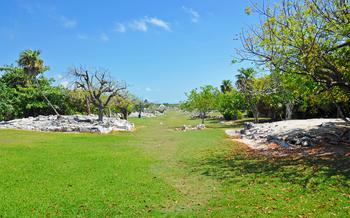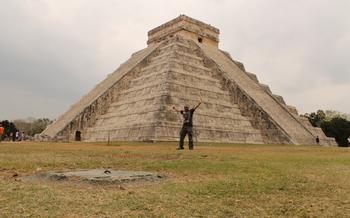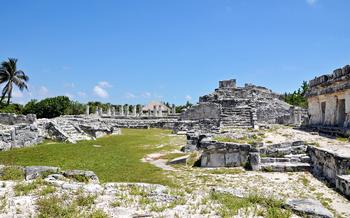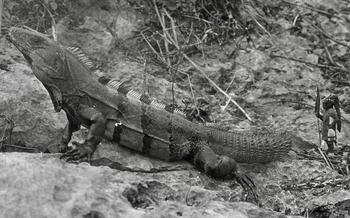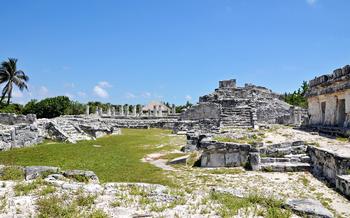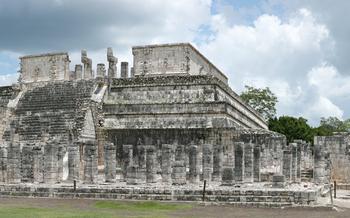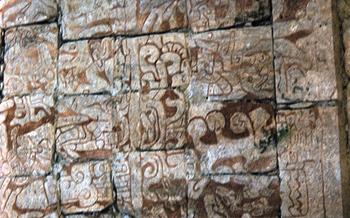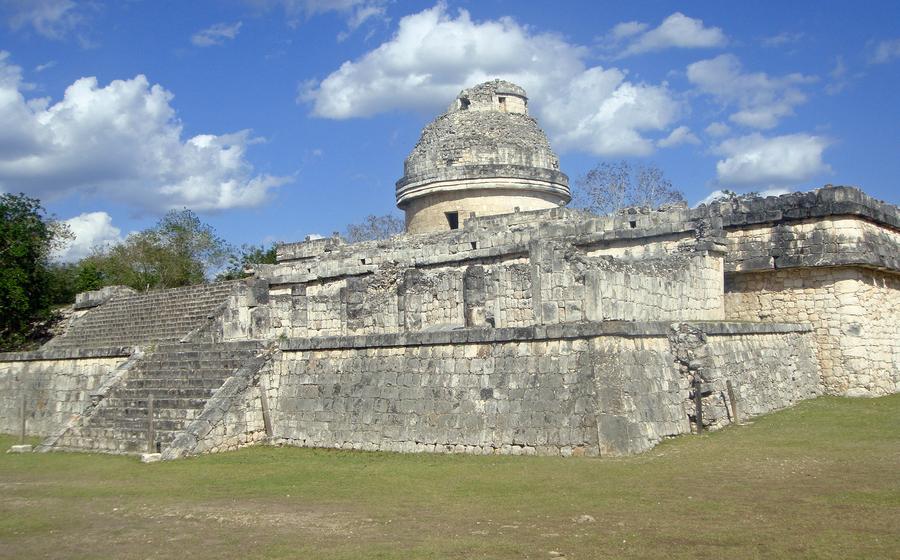
El Caracol (The Observatory)
- El Caracol (The Observatory): A Marvel of Ancient Engineering
- Location and Accessibility
- Visiting El Caracol: Tips for an Unforgettable Experience
- Best Time to Visit
- Must-See Features
- Photography Tips
- Exploring Mayan Astronomy at El Caracol
- El Caracol in Context: A Glimpse into Maya Civilization
- Comparing El Caracol to Other Ancient Observatories
- El Caracol and the Legacy of Maya Astronomy
- Tips for Visiting Chichen Itza as a Responsible Traveler
- Unforgettable Experiences at Chichen Itza
- Additional Must-See Sites in Chichen Itza
- Planning Your Chichen Itza Adventure
- Safety Tips for Exploring Chichen Itza
- Fascinating Facts and Legends about El Caracol
- Insider Tip: Unveiling the Hidden Details of El Caracol
El Caracol (The Observatory): A Marvel of Ancient Engineering
El Caracol, meaning "The Snail" in Spanish, is a marvel of ancient engineering and one of the most significant structures within the Chichen Itza archaeological site. Built by the Maya civilization between the 9th and 11th centuries AD, El Caracol served as an astronomical observatory, demonstrating the Maya's advanced knowledge of astronomy and their deep connection to the cosmos. Its unique round structure, precise alignments with celestial events, and intricate carvings offer a glimpse into the ingenuity and sophistication of Maya science and culture.
El Caracol's round shape is a unique feature among Maya structures, setting it apart from the more common rectangular or square buildings. This circular design allowed for uninterrupted views of the horizon in all directions, enabling the Maya astronomers to make precise observations of the sun, moon, and stars. The observatory's interior features a spiral staircase leading to an upper chamber, where astronomers could make their observations through strategically placed windows aligned with significant celestial events.
The Maya's astronomical knowledge was remarkably advanced, and El Caracol played a crucial role in their understanding of celestial cycles. They used the observatory to track the movement of the sun and moon, predict eclipses, and determine the timing of important agricultural and religious events. The intricate carvings and inscriptions found within El Caracol provide valuable insights into Maya astronomy, including their sophisticated calendrical system and their ability to measure the length of the solar year with remarkable accuracy.
El Caracol's cultural significance extended beyond its astronomical function. It served as a sacred place where religious ceremonies and rituals were performed. The Maya believed that the observatory was a conduit between the earthly and spiritual realms, allowing them to communicate with the gods and ancestors. Its unique design and intricate carvings reflect the Maya's deep reverence for the cosmos and their belief in the interconnectedness of the natural and supernatural worlds.
Location and Accessibility
El Caracol is located in the Maya city of Chichen Itza, on the Yucatán Peninsula in Mexico. To reach Chichen Itza, you can fly into the nearest international airport in Cancun (CUN) and rent a car or take a bus to the site. Alternatively, you can join a guided tour from Cancun or other nearby cities, which typically include transportation to and from Chichen Itza.
Once you arrive at the archaeological site, El Caracol can be found in the central area, near the Great Pyramid (El Castillo). Walking is the best way to explore the site, but there are also guided tours available that can provide insights into the history and significance of El Caracol and other Mayan structures.
Visiting El Caracol: Tips for an Unforgettable Experience
Best Time to Visit
For the best experience, visit El Caracol during the early morning or late afternoon to avoid the midday heat and crowds. The golden light of dawn and dusk also enhances the beauty of the observatory and provides excellent photo opportunities.
Must-See Features
Don't miss the spiral staircase that leads to the observation platform, offering stunning views of the surrounding landscape. Pay attention to the intricate carvings on the walls, which depict various astronomical symbols and celestial events. The observation windows are strategically positioned to align with important astronomical events, such as solstices and equinoxes.
Photography Tips
To capture the best photographs of El Caracol, use a wide-angle lens to capture the entire structure in one frame. Experiment with different angles and perspectives to create unique and dynamic compositions. Use a tripod for stability and to avoid camera shake, especially when shooting in low-light conditions.
Exploring Mayan Astronomy at El Caracol
El Caracol's primary purpose was astronomical observation and tracking. The Maya were skilled astronomers who used the observatory to align with significant celestial events, such as solstices and equinoxes. These alignments were crucial for their calendar system, agricultural practices, and religious ceremonies.
The Maya observed the movement of the sun, moon, and stars using El Caracol. They noted the positions of these celestial bodies and recorded their movements. This data allowed them to create accurate calendars that predicted astronomical events, including eclipses and the changing of the seasons.
One of the most impressive features of El Caracol is its ability to align with the sun during the spring and fall equinoxes. During these events, the sun rises directly over the eastern edge of the observatory's main doorway, casting a beam of light directly into the interior. This alignment demonstrates the Maya's precise understanding of the sun's movement and its significance in their calendar and agricultural practices.
El Caracol is a testament to the Maya's advanced knowledge of astronomy. It showcases their ability to observe and understand the cosmos and use this knowledge to create accurate calendars and predict astronomical events.
El Caracol in Context: A Glimpse into Maya Civilization
The Maya civilization had a profound understanding of the cosmos and their place within it. El Caracol reflects their unique cosmological beliefs, which centered around the idea of a three-tiered universe consisting of the underworld, the earthly realm, and the heavens. The observatory was believed to be a gateway between these realms, allowing the Maya to communicate with the gods and understand the cycles of the universe.
Religious rituals and ceremonies were an integral part of Maya life, and El Caracol played a significant role in these practices. Astronomical events, such as solstices and equinoxes, were considered sacred and were marked with special ceremonies. The Maya believed that the movements of the sun, moon, and stars influenced the agricultural cycle, the weather, and human affairs. El Caracol allowed them to track these celestial events and make predictions about the future, which was crucial for planning agricultural activities and religious festivals.
In everyday life, the Maya relied on astronomy for various practical purposes. The accurate observation of the sun's position helped them determine the time of day, plan their agricultural activities, and navigate long distances. The Maya also used astronomy to create calendars that were essential for tracking the seasons, predicting weather patterns, and organizing religious ceremonies.
Comparing El Caracol to Other Ancient Observatories
El Caracol stands as a testament to the ingenuity and astronomical prowess of the Maya civilization. While it shares similarities with other ancient observatories around the world, such as Stonehenge and the Great Pyramids, it also possesses unique features that set it apart.
Stonehenge, located in England, is a prehistoric monument consisting of large standing stones arranged in a circular pattern. It is believed to have been used for astronomical observations, but its exact purpose remains a mystery. Unlike El Caracol, Stonehenge lacks the intricate carvings and precise architectural alignment that characterize the Maya observatory.
The Great Pyramids of Giza, Egypt, are another example of ancient architecture with astronomical significance. Built as tombs for pharaohs, the pyramids were aligned with the stars and served as symbols of the pharaoh's divine power. However, they lack the specialized astronomical features found in El Caracol, such as the spiral staircase and observation windows.
El Caracol's round shape is a unique feature that sets it apart from other ancient observatories. This design allowed the Maya to observe the sky from different angles, providing them with a more comprehensive view of celestial phenomena. Additionally, the intricate carvings and inscriptions found on El Caracol demonstrate the Maya's advanced understanding of mathematics and astronomy.
In terms of historical context, El Caracol was built during the Classic period of Maya civilization (250-900 AD), while Stonehenge dates back to the Neolithic period (3000-2000 BC) and the Great Pyramids were constructed during the Old Kingdom period of ancient Egypt (2686-2181 BC). These different historical contexts reflect the diverse cultural and technological developments that gave rise to these ancient observatories.
By comparing El Caracol to other ancient observatories, we gain a deeper appreciation for the unique contributions of the Maya civilization to the field of astronomy. Its advanced design and precise alignments demonstrate the Maya's remarkable knowledge of the cosmos and their ability to harness this knowledge for practical and ceremonial purposes.
El Caracol and the Legacy of Maya Astronomy
El Caracol's enduring impact: The legacy of Maya astronomy and El Caracol continues to resonate today. This ancient observatory stands as a testament to the ingenuity and intellectual achievements of the Maya civilization. Its influence can be seen in the development of astronomy and mathematics in other cultures, including the Arabs and Europeans.
Modern research and discoveries: In recent years, there has been a resurgence of interest in Maya astronomy and El Caracol. Researchers are using advanced technologies and techniques to study the observatory and gain new insights into its functions and significance. These studies have revealed that El Caracol was not only an astronomical observatory but also a complex religious and ceremonial center.
Preservation and conservation: El Caracol and other Maya archaeological sites face various threats, including looting, vandalism, and the effects of climate change. Conservation efforts are underway to protect and preserve these sites for future generations. UNESCO has designated Chichen Itza as a World Heritage Site, and various organizations are working to raise awareness and promote responsible tourism. By preserving El Caracol and other Maya sites, we can ensure that their legacy continues to inspire and fascinate people worldwide.
Tips for Visiting Chichen Itza as a Responsible Traveler
As you explore the wonders of Chichen Itza, it's essential to embrace responsible tourism practices that respect the site's cultural significance, minimize environmental impact, and support local communities. Start by dressing appropriately, avoiding revealing or disrespectful clothing, and refraining from touching or climbing on ancient structures. Remember that these ruins are sacred to the Maya people, and showing respect is paramount.
To support the local economy, purchase souvenirs from local vendors rather than large chain stores. This helps sustain the livelihoods of artisans and small businesses. Consider dining at local restaurants that serve traditional Maya cuisine to savor authentic flavors and support local culinary traditions. Hiring local guides not only provides you with valuable insights but also contributes directly to the local economy.
By embracing responsible tourism, you can help preserve Chichen Itza for future generations while showing respect for the Maya culture and contributing positively to the local community.
Unforgettable Experiences at Chichen Itza
Attending the Equinox Celebrations:
Immerse yourself in the vibrant cultural heritage of the Maya by attending the remarkable equinox celebrations at Chichen Itza. During the spring and fall equinoxes, the site comes alive with an array of traditional ceremonies, rituals, and performances that evoke the spirit of this ancient civilization. Witness the awe-inspiring phenomenon of the descending serpent god Kukulcan as sunlight casts shadows that create the illusion of a snake slithering down the steps of the Great Pyramid. Participate in the lively festivities, savor the delicious local cuisine, and connect with the rich history and traditions of the Maya people. This once-in-a-lifetime experience will leave you with lasting memories and a deeper appreciation for the profound legacy of this extraordinary culture.
Exploring the Cenotes:
Unveil the hidden wonders of the Yucatan Peninsula by venturing into the mystical cenotes, or natural sinkholes, that dot the landscape around Chichen Itza. These sacred water-filled caverns were considered portals to the underworld by the Maya and hold immense cultural and ecological significance. Dive into the refreshing turquoise waters for a swim or snorkel amidst the awe-inspiring underwater world, surrounded by stalactites, stalagmites, and colorful marine life. Discover the ancient legends and rituals associated with these mystical cenotes and immerse yourself in the breathtaking beauty of nature.
Discovering the Sacred Cenote:
Journey to the heart of Maya spirituality by visiting the Sacred Cenote, a revered site that played a pivotal role in ancient Maya religious rituals. Located a short distance from the main archaeological zone, this natural well was considered a sacred portal to the underworld, where offerings were made to appease the gods and communicate with the spirit world. Gaze into the depths of the cenote and imagine the ancient Maya performing their sacred ceremonies, seeking guidance and protection from their deities. Pay your respects to this sacred site and marvel at the enduring power of the Maya spiritual traditions.
Additional Must-See Sites in Chichen Itza
Chichen Itza is home to a variety of other impressive structures that are worth exploring in addition to El Caracol. One of the most iconic landmarks is the Great Pyramid, also known as El Castillo. This massive pyramid is a testament to the Maya's architectural prowess and is one of the most recognizable structures in the world. Visitors can climb to the top of the pyramid for stunning views of the surrounding jungle and the other ruins.
Another must-see site is the Temple of the Warriors. This temple is located near the Great Pyramid and is known for its intricate carvings and impressive size. The temple was once used for religious ceremonies and rituals and is a great place to learn more about Maya culture.
The Great Ball Court is another fascinating site in Chichen Itza. This massive court was used for a ceremonial ball game that was an important part of Maya culture. The court is surrounded by towering walls and is an impressive sight to behold.
Planning Your Chichen Itza Adventure
Planning a trip to Chichen Itza requires careful preparation to ensure a smooth and enjoyable experience. Here are some essential considerations to make:
Essential Packing List: Pack comfortable shoes for walking on uneven terrain, as well as sun protection, such as a hat, sunglasses, and sunscreen. A refillable water bottle is crucial to stay hydrated in the hot climate. Consider bringing insect repellent and a small flashlight for exploring dimly lit areas.
Accommodation Options: Chichen Itza offers a range of accommodation options to suit different budgets and preferences. Budget travelers can find hostels and guesthouses, while those seeking a more luxurious experience can opt for resorts or hotels. It's advisable to book accommodation in advance, especially during peak tourist season.
Dining Recommendations: Chichen Itza has a variety of dining options, from local restaurants serving traditional Maya cuisine to international restaurants offering a range of cuisines. Try local specialties such as cochinita pibil (slow-roasted pork) and panuchos (fried tortillas filled with beans and meat). For a unique experience, consider dining at a restaurant with a view of the ancient ruins.
Safety Tips for Exploring Chichen Itza
General Safety Precautions:
When visiting Chichen Itza, it is essential to prioritize your safety. Be aware of your surroundings and take precautions to avoid potential risks. Keep an eye on your belongings to prevent pickpocketing, especially in crowded areas. Avoid isolated areas, particularly at night, and always stay hydrated by carrying a refillable water bottle, as the climate can be hot and humid.
Respecting Cultural Norms:
Demonstrating respect for local customs and traditions is crucial when visiting Chichen Itza. Dress modestly and appropriately, covering your shoulders and knees, to avoid offending local sensibilities. When taking photographs, always ask permission from people before capturing their images. This simple gesture shows respect for their privacy and helps foster a positive interaction.
Wildlife Encounters:
Chichen Itza is home to diverse wildlife, including snakes, insects, and birds. While these creatures are generally harmless, it is important to maintain a safe distance and avoid touching or feeding them. If you encounter any wildlife, remain calm and give them space to move away. In case of any concerns or encounters with aggressive animals, immediately seek assistance from park rangers or local authorities.
Fascinating Facts and Legends about El Caracol
El Caracol holds a wealth of fascinating facts and captivating legends that add to its mystique. Its remarkable astronomical accuracy is a testament to the Maya's profound knowledge of celestial phenomena. The observatory's ability to predict solar and lunar eclipses with precision continues to astound modern astronomers.
Legends and myths abound about El Caracol, weaving a tapestry of intrigue around its history. One legend tells of its construction by a wise Maya astronomer named Itzamná, who used his supernatural powers to align the observatory with the heavens. Another myth suggests that the observatory was a portal to the underworld, allowing the Maya to communicate with their ancestors.
In recent years, ongoing research and discoveries have shed new light on El Caracol's mysteries. Advanced mathematical techniques have been employed to analyze its design and astronomical functions, revealing intricate patterns and relationships that deepen our understanding of Maya scientific knowledge.
Insider Tip: Unveiling the Hidden Details of El Caracol
Beyond the main features of El Caracol, take the time to explore its lesser-known details to gain a deeper appreciation for its complexity. Look for the small niches and passageways that may have served specific astronomical or ceremonial purposes. These hidden features offer a glimpse into the intricate thought and design that went into the construction of this ancient observatory. Additionally, consider hiring a local guide who can provide in-depth knowledge and personalized explanations of El Caracol and other attractions in Chichen Itza. Their insights can help you uncover the hidden stories and significance of this remarkable site, making your visit even more memorable.
